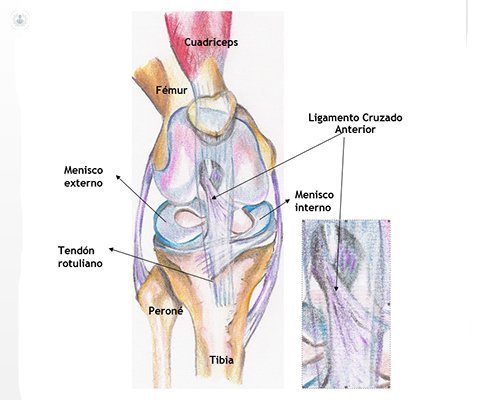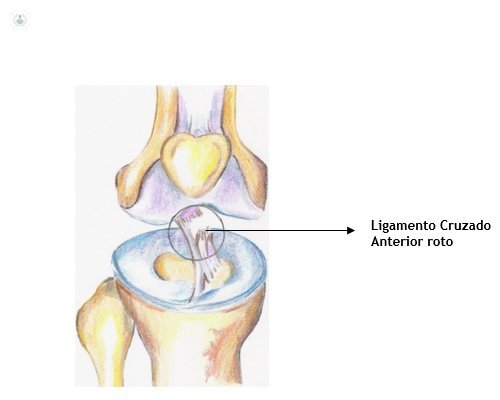Injuries and fractures Anterior Cruciate Ligament
Written by:The anterior cruciate ligament is a bundle of collagen fibers which lies between the femur and tibia obliquely. Its function is to act as the main obstacle to the anterior displacement of the tibia, and thus limit the tibial rotation and external and internal angulation of the knee when fully stretched.
Of the four major ligaments of the knee, the anterior cruciate ligament is the one most commonly injured.

Anterior Cruciate Ligament Injury Frequently
The Anterior Cruciate Ligament rupture occurs with a sudden change in the direction of the knee to decelerate suddenly, for example when falling ill and supporting the limb after a jump or when standing up suddenly after running.
Women are often more likely to injure their anterior cruciate ligament because of their anatomical characteristics: increased joint laxity, wider pelvis that determines an external rotation of the tibia, and the place where the Anterior Cruciate Ligament staying at the knee , the recess is smaller than in males.
Symptoms of ruptured Anterior Cruciate Ligament
The symptoms that the patient vary depending on the type of ligament rupture:
- Acute Rupture can cause one or more of the following symptoms:
- The patient feels or hears a "crack" in the joint
- Instability of the knee, so he fails, with feeling that can not stand him
- moderate or severe inflammation
- Difficulty to support the injured limb
- There may be limitations to bend and stretch due to pain, to an associated meniscal injury or other factors
- Deficiency Chronic Anterior Cruciate Ligament may result from:
- A Break not recent, ie caused more than six weeks, full or partial ago.
- Elongation or stretching by a non recent knee injury.
A break or a chronic deficiency Anterior Cruciate Ligament cause a translation and an abnormal rotation of the tibia. This means that when walking or running can injure one or both menisci and cartilage, causing osteoarthritis. Without the cartilage, bones of the femur and tibia rub unprotected, osteoarthritis progresses and the patient has pain, inability to walk or stand or walk up and down stairs.

Treatment for ruptured Anterior Cruciate Ligament
The Anterior Cruciate Ligament broken melts as braided rope and will not heal by itself, needs diagnosis and treatment by a specialist orthopedic surgeon .
The decision whether to perform a surgical or nonsurgical treatment depends on multiple variables for each individual.
1) Nonsurgical Treatment
The circumstances in which you can specify are as follows:
- Advanced age and level of physical activity of the patient under.
- Instability of the knee and low level of physical activity.
- If there is no associated as broken menisci, ligaments or cartilage injury.
Nonsurgical treatment consists of:
- Injured ability to fulfill a long rehabilitation program, that has muscle strengthening quadriceps and hamstrings.
- Often a stabilizing knee brace is required to perform certain sports, especially where there is a rotational stress of the knee, or just walking as a personal decision.
- It may require changing the level and type of sports.
2) Anterior Cruciate Ligament Surgery
Reconstructive surgery of the anterior cruciate ligament injured knee recovers completely. Are candidates for surgery patients:
- A recent break Anterior Cruciate Ligament and active lifestyle.
- chronic ACL deficiency that causes instability of the injured knee meniscus and cartilage.
- Ligament rupture and sports where necessary:
- Jumping or running (impact sports).
- Stopped abruptly.
- Turn sharply knee while remaining the foot on the ground.
Without surgery, these patients can not return to their sport due to the instability of the knee, as well as presenting a high risk of other injuries.
Lesions associated with ruptured Anterior Cruciate Ligament
- Menisci: more than 50% of Anterior Cruciate Ligament tears are accompanied by meniscal injury. The goal is to reconstruct the anterior cruciate ligament and meniscus repair or rebuild by meniscal suturing techniques.
- Other ligaments: may be required in addition injured ligament reconstruction Anterior Cruciate Ligament.
- Cartilage need to repair damaged cartilage in addition to reconstruct the anterior cruciate ligament.


